ARNSTADT 10 PFENNIG SERIES NOTES 1921 |
On this page you will find a set of small denomination German Series Notes (Serienscheine) printed and distributed by the City of Arnstadt in 1921. This is an interesting series of notes bearing short political themed messages with illustrations by the artist / illustrator Paul A. Weber from Arnstadt. Weber is best known for his dark and illustrative lithographic prints that provide social commentary and satire of early 20th-century German culture, politics, and society. These bills address very real problems faced in Germany at the time. Hunger, poverty, inflation, profiteering, and taxes. Each bill has, on the common reverse, a promise to redeem these bills though on the obverse of one bill (bottom) they urge you not to. Often bills like these were intended to be a method of raising funds. It is preferable to the issuer if they are kept and collected thus never redeemed. |
 |
|
The German artist / illustrator Andreas Paul Weber from Arnstadt |
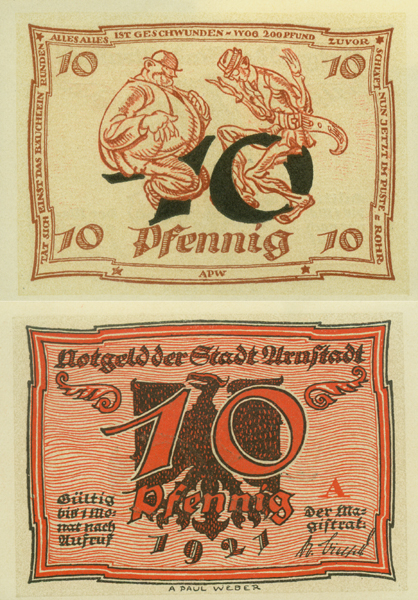 |
|
Notgeld der Stadt Arnstadt 10 pf. (Emergency money for the city of Arnstadt 10 pfennig): Depicted on the obverse are two men, one corpulent and jolly, the other very thin with tightened belt / On the Reverse is an eagle with open claws and wings spread which serves as the coat of arms for the city / Tat sich einst das Bäuchlein runden Alles alles ist geschwunden wog 200 Pfund zuvor Schläft nun jetzt im Pusterohr / gultig bis 1 mo mit nach aufruf / Der Magistrat: (Signed) 1921 Marked "A" (Rough translation: Once the belly was round, then everything (ie. every kilo) has gone; weighed 200 pounds before, can now sleep in a straw / Good for one month after call) / illustration signed APW (Andreas Paul Weber) |
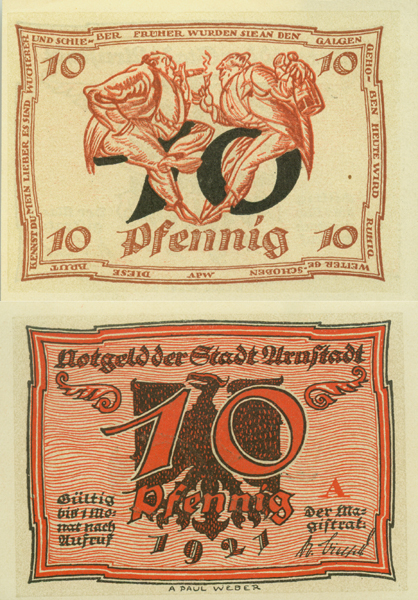 |
Notgeld der Stadt Arnstadt 10 pf. (Emergency money for the city of Arnstadt 10 pfennig): Depicted on the obverse are two wealthy men dressed in nice suits, smoking cigars and drinking / On the Reverse is an eagle with open claws and wings spread which serves as the coat of arms for the city / Diese brut kennst du mein lieber es sind wucherer und schieber fruher wurden sie an den galgen gehoben heute wird ruhig weiter geschoben / gultig bis 1 mo mit nach aufruf / Der Magistrat: (Signed) 1921 Marked "A" (This brood know you my dear they are usurers and racketeers - in former times they were sent to the gallows, today they calmly (smoothly?) continue to traffic / Good for one month after call) / illustration signed APW (A Paul Weber) |
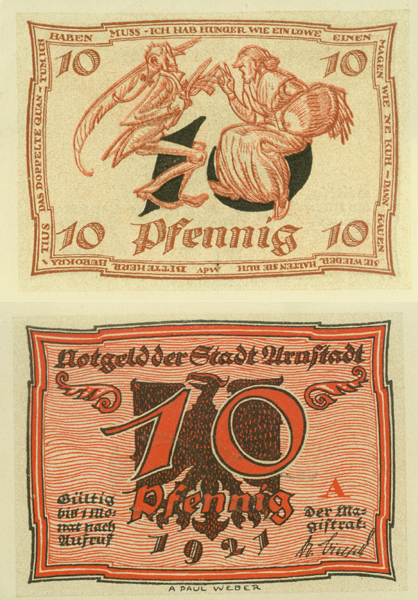 |
Notgeld der Stadt Arnstadt 10 pf. (Emergency money for the city of Arnstadt 10 pfennig): Depicted on the obverse is a woman talking to a clerk or government official with a big quill behind his ear cutting what appears to be ration tickets / On the Reverse is an eagle with open claws and wings spread which serves as the coat of arms for the city / Bitte Herr Burorkatius das doppelte quantum ich haben muss. Ich habe hunger wie ein lowe einen magen wie 'ne kuh dann kauen sie wieder, halten sie ruh / gultig bis 1 mo mit nach aufruf / Der Magistrat: (Signed) 1921 Marked "A" (Please, Mr Bureaucratius, I need to have the double quantity. I am as hungry as a lion, have a stomach like a cow - Then chew your cud and shut up. / Good for one month after call) / illustration signed APW (A Paul Weber) |
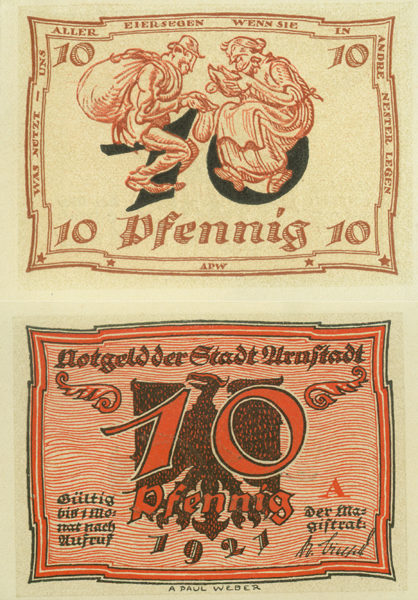 |
Notgeld der Stadt Arnstadt 10 pf. (Emergency money for the city of Arnstadt 10 pfennig): Depicted on the obverse is a woman with a hen and a man with a sack catching the egg right as it is laid / On the Reverse is an eagle with open claws and wings spread which serves as the coat of arms for the city / Was nutzt uns aller eiersegen, wenn sie in andre nester legen? / gultig bis 1 mo mit nach aufruf / Der Magistrat: (Signed) 1921 Marked "A" (What good are all this egg yield if they are put in other (people's) nests? / Good for one month after call) / illustration signed APW (A Paul Weber) |
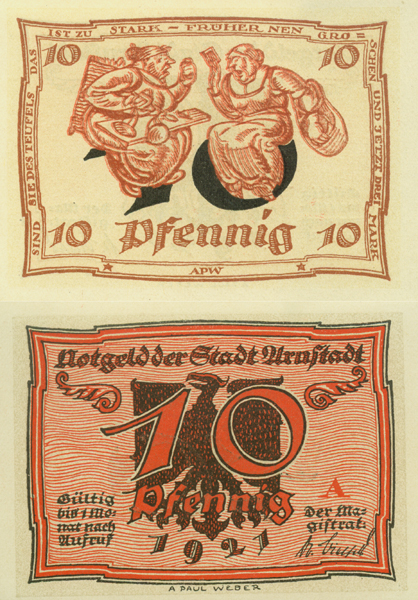 |
Notgeld der Stadt Arnstadt 10 pf. (Emergency money for the city of Arnstadt 10 pfennig): Depicted on the obverse are two market frau in animated conversation / On the Reverse is an eagle with open claws and wings spread which serves as the coat of arms for the city / Sind sie des teufels das ist zu stark fruher 'nen groschen und jetzt drei marke / gultig bis 1 mo mit nach aufruf / Der Magistrat: (Signed) 1921 Marked "A" (Have you gone mad, that is too much - formerly a groschen, and now three mark / Good for one month after call) / illustration signed APW (A Paul Weber) |
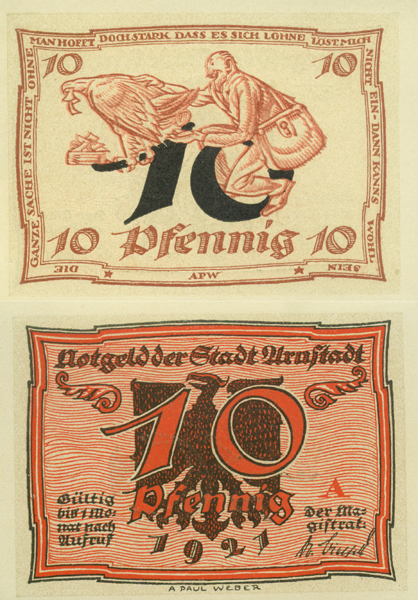 |
Notgeld der Stadt Arnstadt 10 pf. (Emergency money for the city of Arnstadt 10 pfennig): Depicted on the obverse is an eagle eating what is probably notgeld and laying an egg / On the Reverse is an eagle with open claws and wings spread which serves as the coat of arms for the city / Die ganze Sache ist nicht ohne · man hofft doch stark · dass es sich lohne · löst mich nicht ein - dann kanns wohl sein / Der Magistrat: (Signed) 1921 Marked "A" (The whole thing is not bad · one firmly hopes · that it pays off · do not cash (redeem) me - then it may well be / Good for one month after call) / illustration signed APW (A Paul Weber) |
Arnstadt is a town located in the district of Ilm-Kreis, in the state of Thuringia, Germany. The town is situated on the edge of the Thuringian Forest and the banks of the Gera River. One of the oldest towns in Thuringia, it is nicknamed Das Tor zum Thüringer Wald, (The Gate to the Thuringian Forest).
The family of Johann Sebastian Bach hail from Thuringia, many in and and around Arnstadt. Shortly after graduating from the prestigious St. Michael's School in Lüneburg, Bach began his professional music career as the organist at St. Boniface's Church in Arnstadt. He held this position from 1703 to 1706 when he moved to the larger city of Mühlhausen to accept the job of organist and musical director at St. Blasius's. It was a better position, higher pay, and it allowed him a break from family matters and problems back in Arnstadt. Shortly after this move he married his second cousin from Arnstadt, Maria Barbara Bach.
According to minutes from the proceedings of the Arnstadt consistory in August 1705, Bach was involved in a brawl in Arnstadt:
"Johann Sebastian Bach, organist here at the New Church, appeared and stated that, as he walked home yesterday, fairly late night ... six students were sitting on the "Langenstein" (Long Stone), and as he passed the town hall, the student Geyersbach went after him with a stick, calling him to account: Why had he [Bach] made abusive remarks about him? He [Bach] answered that he had made no abusive remarks about him, and that no one could prove it, for he had gone his way very quietly. Geyersbach retorted that while he [Bach] might not have maligned him, he had maligned his bassoon at some time, and whoever insulted his belongings insulted him as well ... [Geyersbach] had at once struck out at him. Since he had not been prepared for this, he had been about to draw his dagger, but Geyersbach had fallen into his arms, and the two of them tumbled about until the rest of the students ... had rushed toward them and separated them."
For much of its history, Arnstadt was ruled by the counts of Schwarzburg, it served, for a time, as the capitol of Schwarzburg-Sondershausen. Today it is a center for manufacturing and mining with a population of roughly 25,000 people. |







